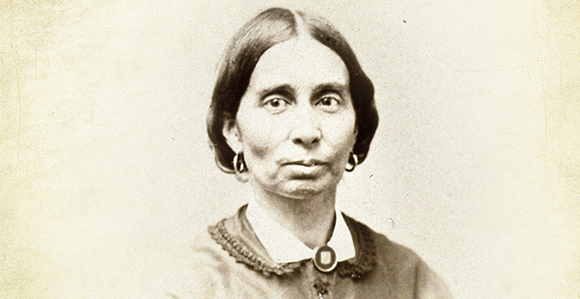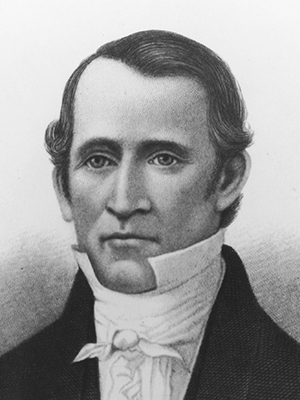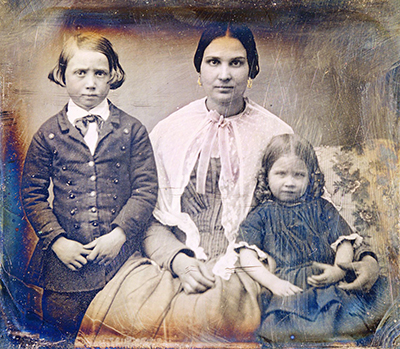Learning from the Life of Eliza Maria Partridge Lyman
Contributed By By Marianne Holman Prescott, Church News staff writer

Eliza Maria Partridge Lyman. Her journal entries often tell of the harsh or difficult situations she and other Church members were facing and then conclude with a sentiment of gratitude and hope.
Article Highlights
- Eliza Partridge was born in 1820 and was involved in Missouri, Nauvoo, and moving west to Utah.
- Eliza had many trials in life, but she always found things to be grateful for.
“We stand where they stood because it is not necessarily a physical place, but a place of decision. It’s a place in their hearts, if you will, where they fight the battle to become a man or woman of faith. And we don’t need to go where their battle was because we each have a decision ourselves to become a man or woman of faith.” —Sherilyn Farnes, Church historian
During a Men and Women of Faith lecture sponsored by the Church History Library held May 8 in the Assembly Hall on Temple Square, Church historian Sherilyn Farnes spoke of the inspiring life of Eliza Maria Partridge Lyman.
Titling her remarks “There Is Sure to Come a Ray of Light,” Sister Farnes shared stories from Eliza’s life—both the enjoyable and the hard times—highlighting the realness of her record and how she always found something to be grateful for in her life.
“I think there is a reason that there are ‘men and women of faith,’ and they’re not ‘men and women who didn’t need faith’ because they have never doubted and never wavered and knew everything will work out,” Sister Farnes said. “But it’s men and women of faith.”
Eliza’s journal entries often tell of the harsh or difficult situations she and other Church members were facing and then conclude with a sentiment of gratitude and hope. “Seeing her as a real person makes her actions of faith that much more meaningful to me. As I realize that life was hard for her and she struggled, and she admits it in her diary, I am grateful to her for that, because then I can relate.”
Eliza was born in the spring of 1820 to Edward and Lydia Partridge as the oldest of seven children. The Partridge family lived in Painesville, Ohio, where her father was a hatter. In fall of 1830, her family would meet missionaries and join the Church. Less than two months after his baptism, Edward Partridge was called to be the Church’s first bishop following the Restoration of the gospel.
Because of their faith and Brother Partridge’s call as bishop, the Partridge family moved to Missouri, where life was less comfortable than their life in Ohio. With mobs going after the Church leaders, Eliza and her siblings were often scared, and because of persecution, their family moved frequently.
Like many other of the early Saints, hardships fell upon the Partridge family. First, Lydia lost a baby boy at birth, and later, one of Eliza’s sisters fell sick and died. Within two weeks of the death of her sister, her father died, and an ill Eliza was unable to attend the funeral to honor her father. While sick, she and her sister moved into Joseph and Emma Smith’s home, where they both would later become plural wives of Joseph Smith.

Edward Partridge, the father of Eliza Maria Partridge Lyman. Photo courtesy of the Church History Library.

Eliza’s sister Emily Dow Partridge Young and her children. Photo courtesy of the Church History Library.
Upon the Prophet’s death, Eliza was encouraged to marry another man and became a plural wife to the Apostle Amasa Mason Lyman in September 1844. Two of her sisters would also marry Amasa Lyman. Eliza and her siblings—especially her sister Caroline—would remain close throughout their lives.
Eliza would move west with the Saints, settling in the Fillmore, Utah, area. She died and is buried in Oak City, Utah.
Much of Eliza’s life included raising young children in her home. She gave birth to five children—four survived to adulthood—and raised at least four other children as her own when given the opportunity.
After the death of her daughter, Carlie, and at the age of 58, Eliza began raising her grandchild. At that time, she recorded in her journal that she felt too old to be raising an infant but also “thankful to my Heavenly Father for the strength He has given me to enable me to take care of the baby thus far.”
Her husband, Amasa Lyman, was often away from the home on assignments, so for much of her life, she relied upon her family for help and support. Her husband would later leave his apostleship and the Church, but Eliza led their posterity and stayed firm in her faith.
Although times weren’t always easy—as expressed in her journal—Eliza would always write a day or a few days later with a positive outlook on her situation, Sister Farnes taught.
“She couldn’t see the end from the beginning,” said Sister Farnes. “She knew what was in the day, but she always kept trying to look on the bright side.”
It was during those hard times and experiences—hunger, fatigue, cold, sickness, and the death of loved ones—that Eliza decided to be a woman of faith as she forged a friendship with Deity.
Although her trials were, at times, overwhelming, Eliza wrote in 1880: “I often feel as if I had gone as far as I could, but there is sure to come a ray of light from some source and many times where I least expect it, and I cannot but acknowledge the hand of the Lord in my preservation. He leads me through deep waters, but it is all right, and I feel to put my trust in him.”
Just as Eliza and many of the early Saints were able to use their experiences to become men and women of faith, individuals today can learn from history as they decide to become men and women of faith, Sister Farnes taught.
“We stand where they stood because it is not necessarily a physical place, but a place of decision. It’s a place in their hearts, if you will, where they fight the battle to become a man or woman of faith. And we don’t need to go where their battle was because we each have a decision ourselves to become a man or woman of faith.”
